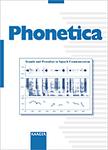版权所有:内蒙古大学图书馆 技术提供:维普资讯• 智图
内蒙古自治区呼和浩特市赛罕区大学西街235号 邮编: 010021

作者机构:Univ Texas Dept Linguist Austin TX 78712 USA Stockholm Univ Dept Phonet S-10691 Stockholm Sweden
出 版 物:《PHONETICA》 (语音学)
年 卷 期:2004年第61卷第1期
页 面:2-21页
核心收录:
学科分类:0502[文学-外国语言文学] 05[文学] 1002[医学-临床医学] 0702[理学-物理学]
基 金:NIDCD NIH HHS [R01 DC02014] Funding Source: Medline
主 题:Acoustics Adult Fourier Analysis Fourier Analysis Humans Male Phonetics Signal Processing, Computer-Assisted/instrumentation Sound Spectrography Speech/physiology Speech Acoustics Speech Production Measurement Tape Recording/instrumentation
摘 要:This study investigated stop + vowel coarticulation as a coding mechanism for differentiation of stop place categories in an F2-defined stimulus space. Locus equations (LEs) were used to index the extent of coarticulation in three contexts: ( 1) onset stop + vowel utterances [.CV];(2) within-syllable vowel + coda stop utterances [VC#], and (3) across-syllable/word coda stop + vowel utterances [C#V]. Five speakers of American English and 2 speakers of Persian produced [***2] (English and Persian), [tV(1)C#V(2)t] (English) and [dV(1)C#V(2)t] (Persian) tokens with voiced labial, alveolar/dental, and velar stops surrounded by a variety of vowels. In the across-syllable/word boundary condition [C#V-2] the extent of anticipatory coarticulation was much reduced relative to traditionally measured onset [CV2] syllables. LE slopes derived across the syllable/word boundary, however, still differed between stop places in the same order as onset CVs. LE slopes derived from within-syllable [V1C#] sequences, however, did not differ between stop places. Copyright (C) 2004 S. Karger AG, Basel.